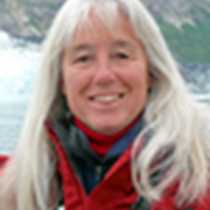Sand Dollar Beach, Isla Magdalena/Hull Canal, Magdalena Bay
We wasted no time immersing ourselves in Baja California and Magdalena Bay, starting with the dunes on Isla Magdalena. Millennia of winds from the northwest and a supply of sand and space created the perfect conditions for this beautiful, dynamic landscape, set between ancient rocky outcrops. Course and fine grains superimposed intricate patterns within the grander scale. We examined interesting plants adapted to the changing environment – wind, sand, and lack of fresh water. Piles of shells are testament to the abundance found by indigenous inhabitants long ago. A short jaunt to the west we encountered the gentle waves of the Pacific Ocean at low tide and myriad treasures offered by the sea. Sand dollars, green worms, mammal and bird bones, and animal tracks related events that no one witnessed. Time and space mingled and were lost in this magical place.
The National Geographic Sea Lion cruised north in the afternoon through the narrow, mangrove-lined Hull Canal under the expertise of our local pilot. The mangrove ecosystem sustains shorebirds, long-legged waders, waterfowl, ospreys, cormorants, gulls, and frigatebirds, which all try to make a living in these rich, protected waters. Bottlenose dolphins are year-round residents and sometimes ride the pressure wave of our vessel. Coyotes search the mudflats with hopes of finding nourishing morsels.
As the channel widened, we saw the spouts of our first gray whales - moms accompanied by their young calves. Magdalena Bay is one of three gray whale calving lagoons on the west coast of the Baja California peninsula. It provides a safe haven for the youngsters while they grow bigger and stronger in order to make the long migration north to the feeding grounds in the Arctic. These are the lovable creatures that we will get to know over the next couple of days, peering into their world in an attempt to understand them and their requirements on the planet that we share.
We wasted no time immersing ourselves in Baja California and Magdalena Bay, starting with the dunes on Isla Magdalena. Millennia of winds from the northwest and a supply of sand and space created the perfect conditions for this beautiful, dynamic landscape, set between ancient rocky outcrops. Course and fine grains superimposed intricate patterns within the grander scale. We examined interesting plants adapted to the changing environment – wind, sand, and lack of fresh water. Piles of shells are testament to the abundance found by indigenous inhabitants long ago. A short jaunt to the west we encountered the gentle waves of the Pacific Ocean at low tide and myriad treasures offered by the sea. Sand dollars, green worms, mammal and bird bones, and animal tracks related events that no one witnessed. Time and space mingled and were lost in this magical place.
The National Geographic Sea Lion cruised north in the afternoon through the narrow, mangrove-lined Hull Canal under the expertise of our local pilot. The mangrove ecosystem sustains shorebirds, long-legged waders, waterfowl, ospreys, cormorants, gulls, and frigatebirds, which all try to make a living in these rich, protected waters. Bottlenose dolphins are year-round residents and sometimes ride the pressure wave of our vessel. Coyotes search the mudflats with hopes of finding nourishing morsels.
As the channel widened, we saw the spouts of our first gray whales - moms accompanied by their young calves. Magdalena Bay is one of three gray whale calving lagoons on the west coast of the Baja California peninsula. It provides a safe haven for the youngsters while they grow bigger and stronger in order to make the long migration north to the feeding grounds in the Arctic. These are the lovable creatures that we will get to know over the next couple of days, peering into their world in an attempt to understand them and their requirements on the planet that we share.



